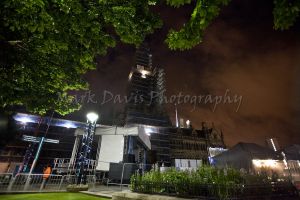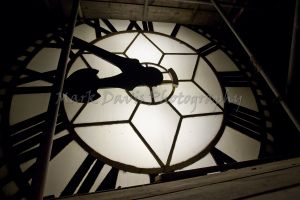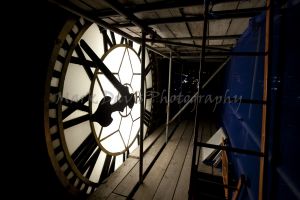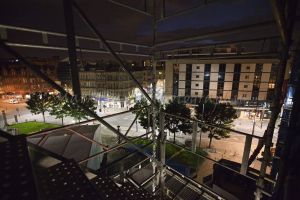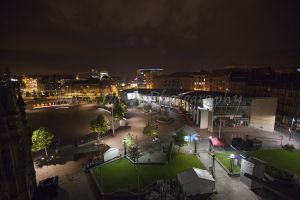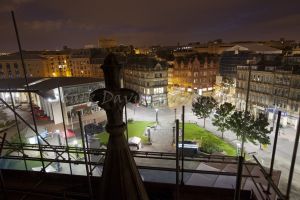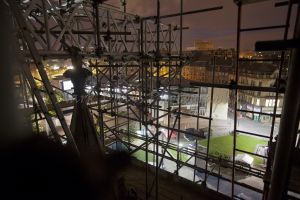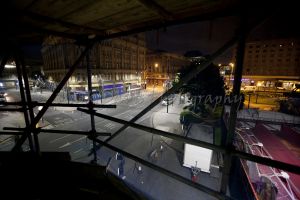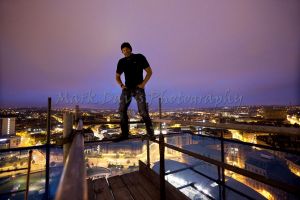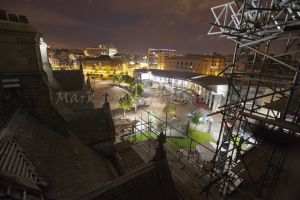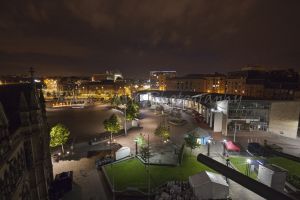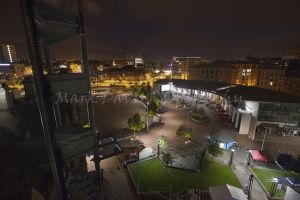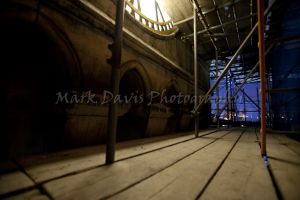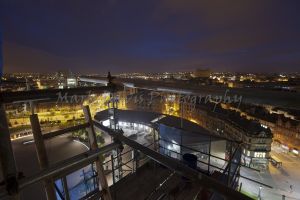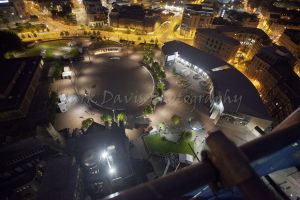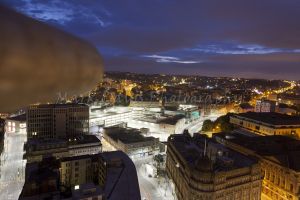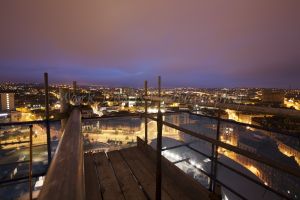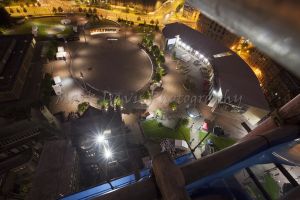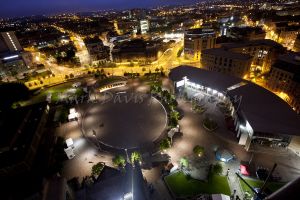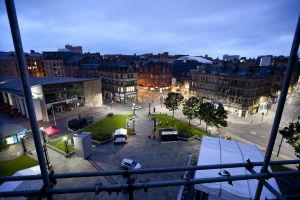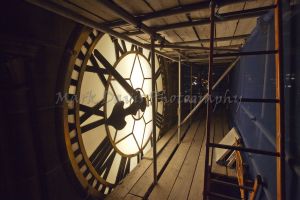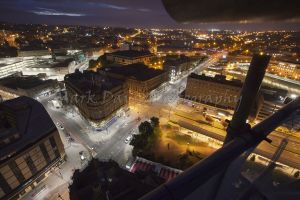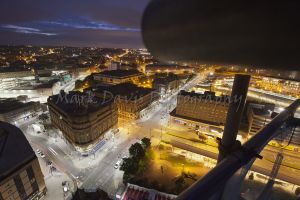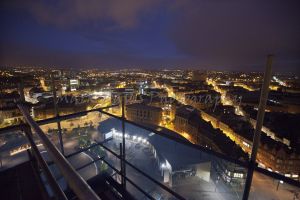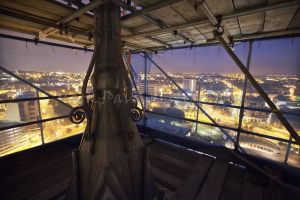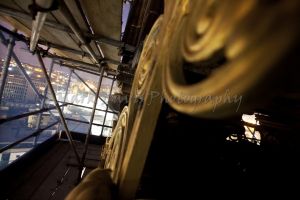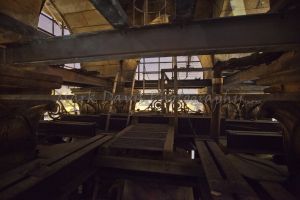Images taken July 2016
Report below from October 2014
Major City Hall renovation enters next phase
A MULTI-MILLION pound project to renovate City Hall is entering its next phase. Conservation specialists are more than half-way through the biggest restoration project undertaken on the Grade I listed landmark in a generation. Much of the work involves repointing, repairing or replacing the stonework around the outside of the Gothic building, but detailed work is also being carried out on its chimneys, roof, stone carvings and decorative balconies. This week, scaffolding along the side of the building facing Channing Way was taken down, as phase two of the project came to an end.
And the third phase, to the frontage of the building facing Centenary Square, is now well under way.
Councillor Andrew Thornton, executive member for the environment at the Labour-led council, welcomed the progress. He said: “They are just finishing off some bits on the ground floor level, which wasn’t accessible when the scaffolding was up. It’s actually quite weird, having come into the building under scaffolding for so long, to see it like this. “Certainly, I think that elevation now looks very good. It has not been sandblasted clean, but it does look much better.”
Over the past year or so, those attending Council meetings at City Hall have grown accustomed to the sounds of powertools and workmen on the scaffolding outside. But a few years ago, the in-depth renovation hadn’t been on the cards. It was during repairs to the ailing roof on the Hall Ings side of the building that a large crack was discovered in one of the chimney stacks, then another was found to be damaged too. While the chimney’s were not in imminent danger of collapse, the authority was worried that they could turn into a safety risk if they were not fixed. Bradford Council building surveyor Richard Young said: “It wasn’t dangerous, but we knew in four or five years it might be.” The Council brought in a specialist conservation surveyor, who advised what repairs they needed to do – but more problems were soon discovered.
Mr Young said: “We could see, from the scaffolding, that we had problems with the chimneys on the other side.” In the end, Bradford Council commissioned a full inspection of the outside of the building. The results suggested the authority was facing a massive repairs bill. Cllr Thornton described the reaction they had to the news. He said: “I don’t think shock is the right word, but our reaction was, ‘Oh. We really need to do something about that.’ “It is fortunate it has been caught in time before it progressed too far. “Nobody had actually been up there or looked at the building in such a long time. Things perhaps went further than they should have been allowed to go. “It is only very recently, in the last four or five years, that we have got into a clear programme of maintenance and investing in our buildings, to make sure we don’t get this kind of thing repeating itself.” Conservation specialists William Anelay Ltd were commissioned to take on the project, and the resulting work is being carried out in four phases, moving around the landmark in a clockwise direction. Mr Young said: “What with it being a Grade I listed building, a lot of it is intervention work rather than replacement. We only replace what is necessary.” Any damaged slabs of stone which do need to be replaced are being lifted out and taken away as templates for new stone pieces. Some of the pieces being removed are so heavy that a crane has had to be brought in to take them down to ground level.
The new stone, once cut to shape, is then lifted into place and where necessary attached to the existing fabric of the building using dowels. Surprisingly, many of the detailed stone carvings which adorn the Gothic landmark have remained relatively unscathed, despite the passage of time. For instance, a series of statues of British monarchs over the centuries, designed by London masonry firm Farmer and Brindley, have held up well. But other details have been touched up, such as the gold leaf on the metal balconies facing onto Channing Way. So far, £3 million has been spent or allocated for the first three phases of work, with the cost of the final phase not yet known. The decision to spend so much on the Council landmark during a time of austerity has been far from a popular one in some quarters. Liberal Democrat leader Councillor Jeanette Sunderland, for instance, has often accused the Labour-led council of having the wrong priorities – cutting access to home care for the elderly and disabled while at the same time painting gold leaf on City Hall. But Cllr Thornton disagreed, saying: “It’s a listed building, so we have to make sure we do things correctly and make sure that it is maintained and remains there in good condition for future generations.” Work is due to be completed by April 2016, and it is not yet clear whether repairs will also be required to the building’s distinctive clock tower.
The tower presents extra challenges, particularly the question of how scaffolding would be put up around it, Mr Young said. A glass roof over the middle of City Hall means that there would be nowhere to rest the scaffolding. Cllr Thornton said: “We want to take a look at the clock tower to make sure that there are no problems there. “So we will be doing that – it’s just a matter of how we are able to do that most effectively.” Bradford City Hall is one of the city’s most distinctive buildings, and was designed to rival the new town halls of Leeds and Halifax. The original building, with its Italianate clock tower, was designed by Bradford architects Lockwood and Mawson after an open competition. It was opened in 1873. The upper parts of the elevations contain 35 statues of the Kings and Queens of England and Oliver Cromwell, created by London masonry firm Farmer and Brindley. An extension at the rear, designed chiefly by the architect Richard Norman Shaw, was completed in 1908.
